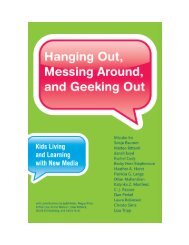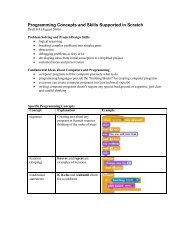Gaming Literacies: A Game Design Study in Action - MIT
Gaming Literacies: A Game Design Study in Action - MIT
Gaming Literacies: A Game Design Study in Action - MIT
Create successful ePaper yourself
Turn your PDF publications into a flip-book with our unique Google optimized e-Paper software.
<strong>Gam<strong>in</strong>g</strong> <strong>Literacies</strong>: A <strong>Game</strong> <strong>Design</strong> <strong>Study</strong> <strong>in</strong> <strong>Action</strong> 311<br />
or any of the other console games present <strong>in</strong> the game lab next door. Members<br />
of the GLS team observed through a one-way mirror <strong>in</strong> the first scenario<br />
and came <strong>in</strong> and out of the open lab <strong>in</strong> the second. All sessions were<br />
videotaped and recorded.<br />
The results of the tests were very encourag<strong>in</strong>g. While there is not space<br />
to document everyth<strong>in</strong>g we discovered, I can offer some general observations.<br />
Please note that while future test<strong>in</strong>g will <strong>in</strong>clude quantitative analysis<br />
with test groups of a much larger size the results presented here are primarily<br />
qualitative. Further, these early notes should be read as prelim<strong>in</strong>ary observations<br />
rather than actual research f<strong>in</strong>d<strong>in</strong>gs.<br />
• The kids were deeply engaged <strong>in</strong> game mak<strong>in</strong>g; when given the<br />
option to play a m<strong>in</strong>i-game that came with the software or to build<br />
a game of their own, every child chose to build their own game.<br />
• When given the choice to mod a game <strong>in</strong> progress or beg<strong>in</strong> with<br />
a blank screen, approximately 90% of the kids opted to start from<br />
scratch. Players quickly learned that they could erase all of the<br />
elements of a partially built game; once this feature was discovered<br />
they moved immediately to erase all elements from the play area <strong>in</strong><br />
order to create a new game 100% of their own design.<br />
• An average session lasted 90 m<strong>in</strong>utes and only ended when we<br />
needed to change groups. The kids did not lose <strong>in</strong>terest dur<strong>in</strong>g this<br />
time, and worked on their games throughout the entire session<br />
without stopp<strong>in</strong>g. Approximately 80% of them asked if they could<br />
keep work<strong>in</strong>g on their games; this group cont<strong>in</strong>ued to make games<br />
<strong>in</strong> the computer lab, without an adult facilitator. When we gathered<br />
all the participants together at the end of the test<strong>in</strong>g session, this<br />
group was eager to share their new games with the others.<br />
• A small percentage of the kids who cont<strong>in</strong>ued mak<strong>in</strong>g games at<br />
the close of their official session chose to build levels for the game<br />
they had completed. Because there was no formal way to l<strong>in</strong>k<br />
levels <strong>in</strong> the prototype, players who decided to make levels had<br />
to come up with the idea on their own. They tended to name their<br />
games as a series (e.g., Incredible 1, Incredible 2, Incredible 3),<br />
and <strong>in</strong>dicated on the game labels they prepared for each game that<br />
the games were part of a s<strong>in</strong>gle, larger game.<br />
• There were significant differences <strong>in</strong> how the boys and girls<br />
designed their games. In general, the girls were <strong>in</strong>itially more<br />
thoughtful <strong>in</strong> their designs and spoke at the beg<strong>in</strong>n<strong>in</strong>g of a session<br />
(as well as throughout) about what they wanted to happen <strong>in</strong>







